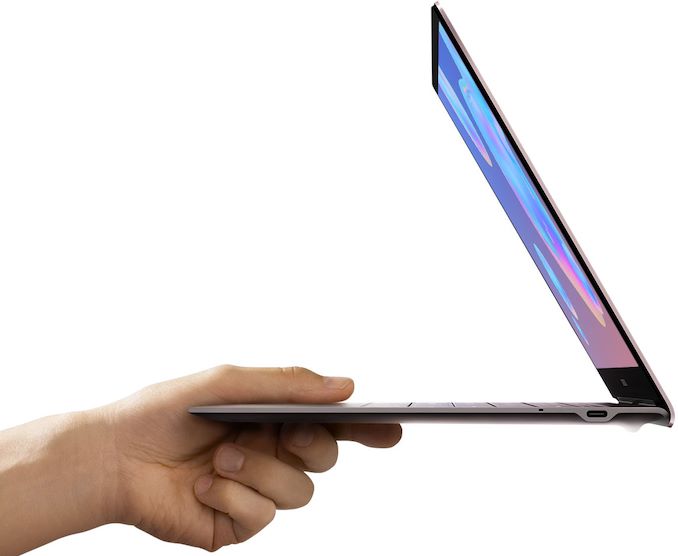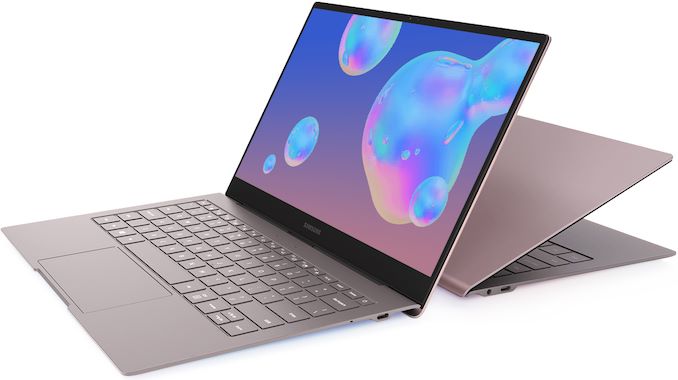Samsung Develops Intel Lakefield-Based Galaxy Book S: Always-Connected x86 PC
by Anton Shilov on October 31, 2019 1:00 PM EST- Posted in
- Notebooks
- Intel
- Samsung
- Laptops
- Galaxy Book
- Lakefield
- Galaxy Book S

Among several items at its developers conference this week, Samsung revealed that it was working on a version of its always-connected Galaxy Book S laptop powered by Intel’s Lakefield processor. When it becomes available in 2020, the notebook is expected to be the first mobile PC powered by Intel’s hybrid SoC, which containing a mix of high-performance and energy-efficient cores.
There are many laptop users nowadays who want their PCs to be very sleek, offer decent performance, be always connected to the Internet, and to last for a long time on a charge. Modern premium x86-based notebooks are very compact and can be equipped with a 4G/LTE modem, but even configured properly, the extra radio brings a hit to battery life over a non-modem model. The immediate solution is of course to use Intel’s low-power/energy-efficient Atom SoCs or Qualcomm's Snapdragon processors tailored for notebooks, but this will have an impact on performance.
To offer both performance and energy efficiency for always-connected notebooks, Intel has developed its Lakefield SoC that features one high-performance Ice Lake core, four energy-efficient Tremont cores, as well as Gen 11 graphics & media cores. Internally, Intel’s Lakefield consists of two dies — a 10 nm Compute die and a 14 nm Base die — integrated into one chip using the company’s Foveros 3D packaging technology to minimize its footprint. Courtesy of Foveros, the chip measures 12×12 mm and can be integrated into a variety of emerging always-connected devices.
As it turns out, Samsung’s upcoming version of the 13.3-inch Galaxy Book S will be the first to use Intel’s Lakefield, where it will be paired with Intel’s 4G/LTE modem to offer Internet connectivity everywhere.
Samsung is not disclosing pricing or availability details for its Lakefield-powered Galaxy Book S; but since Intel plans to start production of the SoC this quarter, expect the machine to launch in 2020.
Related Reading:
- Samsung Announces Always-Connected Galaxy Book S Laptop with Snapdragon 8cx
- Samsung Unveils Galaxy Book2: 12-Inch, Snapdragon 850 with X20 LTE, 20 Hrs
- Hands-On with Industry’s First 5G Laptop: A Lenovo with Qualcomm’s 8cx SoC and X55 Modem
- Qualcomm Tech Summit, Day 3: Snapdragon 8cx, the New ACPC SoC
- Spotted: Qualcomm Snapdragon 8cx Wafer on 7nm
- Lenovo Announces Yoga C630: The First Windows on Snapdragon 850
- Huawei Readies Windows 10 Laptop Based on Qualcomm Snapdragon 850
Source: Intel/Samsung












29 Comments
View All Comments
Diogene7 - Friday, November 1, 2019 - link
Indeed. I would likely mostly watch 1080p video on the laptop itself, but I would prefer a laptop that could decode 4K video to be able to occasionally watch 4K video on a TV or on the laptop itself as more and more 4K video content will become available in tje coming years (it is a bit a future proofing for the next 5 years).Jorgp2 - Friday, November 1, 2019 - link
Lol.He's not the troll here
Mikad - Friday, November 1, 2019 - link
Have you thought about getting Surface Pro? At least the Surface Pro 6's i5 models are fanless and there should also be a 4G model available. And they are quite powerful too.Diogene7 - Friday, November 1, 2019 - link
@Mikad: Thanks for the advice :). Yes indeed, I considered a Microsoft Surface Pro, but I think only the Surface Pro 5 had a fanless version with a LTE option.Also I would much prefer the Surface Pro 7 because it has a USB-C port, which is practical to recharge the device with a USB-C power adapter that could also be used to recharge an Android smartphone when traveling.
Unfortunately, I doubt that Microsoft will launch a LTE version of the Surface Pro 7, and will likely reserve LTE capabilities to the Surface Pro X.
Also even I like 2-in-1 like Surface Pro, I think I prefer laptop with touchscreen, and from there I would prefer a fanless Microsoft Surface laptop 3 with integrated LTE connectivity, but it doesn’t exist either...
Teckk - Friday, November 1, 2019 - link
So Intel is going big.Little and chiplet. Should be interesting to see how people will defend that when they booed AMD and ARMJorgp2 - Friday, November 1, 2019 - link
But AMD hasn't done it.And I've been booed for suggesting it in the AMD subreddit.
Teckk - Saturday, November 2, 2019 - link
AMD's EPYC Rome is Chiplet design. Yeah they don't have it in a mobile SKU yet howeverHardware Geek - Saturday, November 2, 2019 - link
Moving the IO Die to a separate chip is is completely different than using 2 different x86 cores and foveros chip stacking is a very as well. AMD isn't using high power and low power cores on the same processor.Hardware Geek - Saturday, November 2, 2019 - link
That's supposed to be foveros chip stacking is very differentTeckk - Saturday, November 2, 2019 - link
I was referring to the use of 2 different process technology by Intel, like AMD has used in Rome and chiplet, to the extent done by AMD. i did mention ARM initially referring to big.Little.If this is the right way to do things then yeah good for us, Intel will also give even better products. Just that it's funny when others do some sort of implementation, it's ridiculed to be glued or Intel is different and that's the only way. Foveros is probably better and I am not denying that.